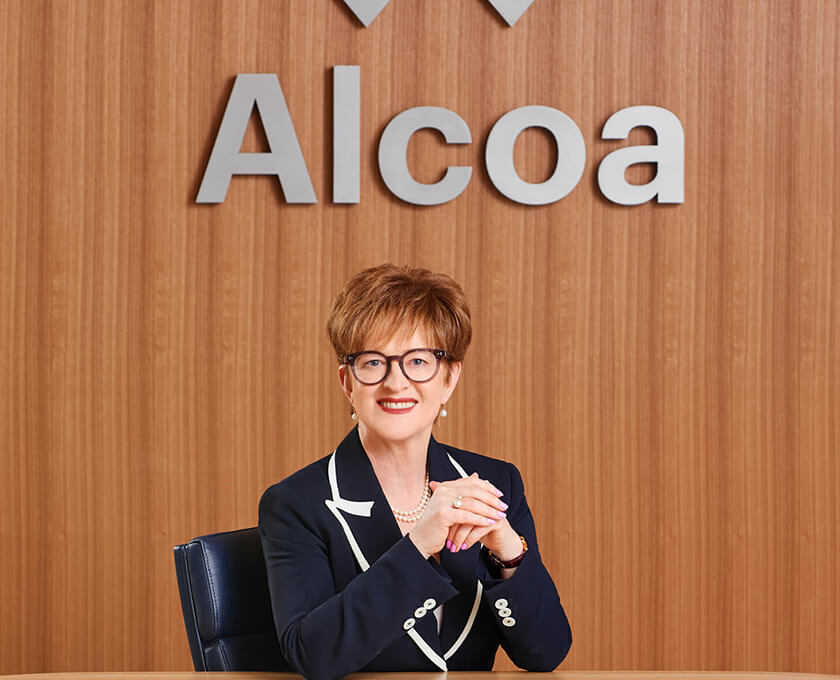September 10, 2025
Responsible Production of Aluminium

Elsabe Muller, President of Alcoa Australia. Opinion piece, as featured in The West Australian
Do you own a smart phone, drive a car, and do you have solar panels on your roof or are you planning a home battery system? If you answered yes to any of these questions, then like me, you need aluminium.
This strong yet light-weight and non-corrosive metal also frames our homes and workplaces, packages our foods, drinks and medicines, and is a key ingredient in medical devices like MRI machines.
Aluminium has been a big part of our daily lives for so long we’ve almost forgotten it’s there. Its role in our future – particularly our decarbonised future – is just as important with the World Bank identifying aluminium as a "high-impact" metal in existing and potential green energy technologies.
Despite already being the second most used metal in the world and being infinitely recyclable, demand continues to rise – by almost 40 per cent by 2030 according to the International Aluminium Institute. Put simply, for our lifestyle and decarbonisation to continue, more aluminium must be produced. And to produce aluminium, more bauxite, its primary source, must be mined.
There’s no argument the primary source of aluminium, bauxite, like all minerals, should be mined responsibly, which means taking care with the environment and people. Nor is there any argument that Australia’s mining industry has some of the highest levels of performance when it comes to responsible production. Australia is also among the world’s largest bauxite producers. Put those things together and it’s clear that if Australian bauxite production falls, focus will shift to other parts of the world where the same high standards may not exist.
Alcoa Australia has operated one of the world’s largest integrated aluminium production chains for more than 60 years, mining bauxite and refining alumina in Western Australia, and smelting aluminium in Victoria. About 6200 employees and contractors work at these operations, which last year contributed $3.3 billion to the nation’s economy including spending $2.7 billion with more than 1700 Australian businesses.
While these figures are impressive, it was Alcoa’s long-standing reputation for operating with care and integrity that was at the forefront of my decision to join the company as its Australian leader almost a year ago. My experience since has validated my decision. I have witnessed firsthand how this business is made up of values-driven people running first-class operations that are responsibly producing a material the world needs.
That said, we cannot shy away from key challenges. We mine bauxite in the world’s only jarrah forest and in Perth’s drinking water catchments, and we operate in the backyard of Peel communities and on the doorstep of the metropolitan area – a very different scenario to most other miners in the State who are in more far-flung parts.
To maintain our licence to operate, we know we must keep pace with evolving environmental needs, community expectations and global leading practice. And we’re doing just that. We are working with the WA Government to modernise our State Agreements, transitioning to the contemporary Environmental Protection Authority (EPA) assessment processes for proposed new mining areas, and continuously reviewing and stepping up how we operate.
We acknowledge that these changes bring increased scrutiny, including a recently completed 12-week public comment period on our current and future mine plans. Through this process, we look forward to better understanding people’s queries and concerns so we can investigate what more we might need to do. We also want to be more transparent so we can allay these queries and concerns where possible. To that end, I’d like to address two key topics.
Firstly, we know our mining impacts the Northern Jarrah Forest. The reality is, that is where the bauxite occurs and that’s why our mining lease is there. Over more than six decades, we have cleared less than 2 per cent of the Northern Jarrah Forest, which is just one part of the broader forest areas in the south-west. There has been extensive clearing in the Northern Jarrah Forest by others, mainly for rural land use. We only mine where logging has previously taken place and take great care to identify and avoid areas of significant environmental, social and cultural value. This includes not clearing old growth forest, areas of important animal habitat, and around the forest towns of Dwellingup and Jarrahdale.
More than 75 per cent of all the areas we have mined are under rehabilitation and at different stages of maturity from decades old to newly planted. Our mine site rehabilitation work has won various accolades with a recent independent review finding it was “as sophisticated and comprehensive as for any mining operation globally”. As well as a rich diversity of native plants returning to areas under rehabilitation, research shows 100 per cent of mammal and about 90 per cent of bird and reptile species have been observed in areas under rehabilitation aged 15-20 years. We are accelerating our work so new areas under rehabilitation tally about 1000 hectares per annum by 2027 and we are investing $15 million over five years into forest research.
Secondly, we know people are concerned our mining could pose a risk to Perth’s drinking water supply. Our operations have never negatively impacted the drinking water supply in the many decades we have been operating in this area. And we’re doing even more to maintain that positive track record. We’re moving further away from drinking water sources and higher risk areas, further improving our mine planning and drainage controls, and fast-tracking rehabilitation work close to reservoirs.